Music and National Identity
VerifiedAdded on 2022/11/28
|12
|3499
|286
AI Summary
This paper explores the interaction between Quan Ho folk music, particularly the La Rang song, and Vietnamese national identity. It discusses the cultural connotations of Quan Ho folk music and the role of music in shaping national identity. The study highlights the contribution made by the Quan Ho folk music genre and the La Rang song towards the national identity of Vietnam.
Contribute Materials
Your contribution can guide someone’s learning journey. Share your
documents today.
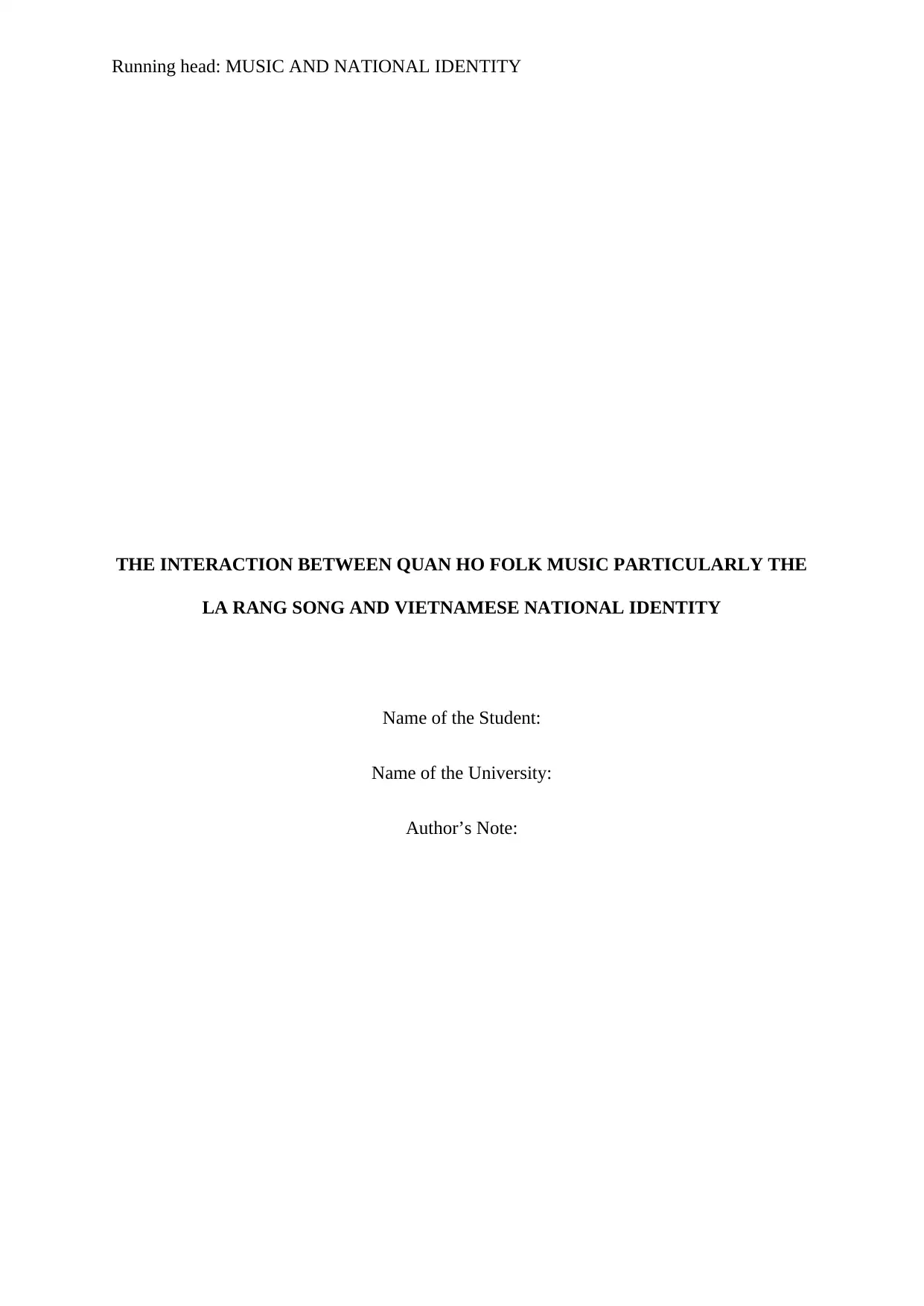
Running head: MUSIC AND NATIONAL IDENTITY
THE INTERACTION BETWEEN QUAN HO FOLK MUSIC PARTICULARLY THE
LA RANG SONG AND VIETNAMESE NATIONAL IDENTITY
Name of the Student:
Name of the University:
Author’s Note:
THE INTERACTION BETWEEN QUAN HO FOLK MUSIC PARTICULARLY THE
LA RANG SONG AND VIETNAMESE NATIONAL IDENTITY
Name of the Student:
Name of the University:
Author’s Note:
Secure Best Marks with AI Grader
Need help grading? Try our AI Grader for instant feedback on your assignments.
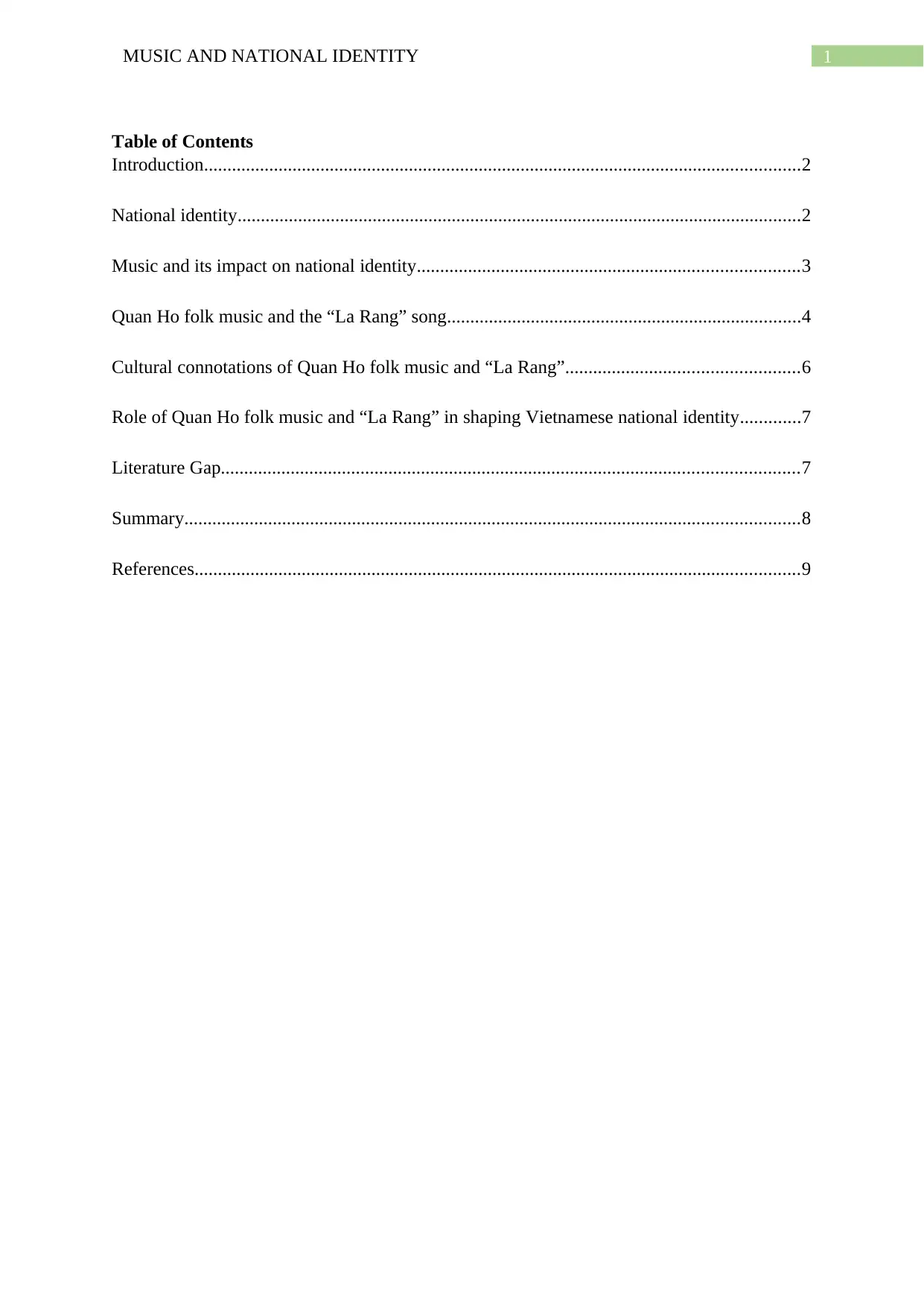
1MUSIC AND NATIONAL IDENTITY
Table of Contents
Introduction................................................................................................................................2
National identity.........................................................................................................................2
Music and its impact on national identity..................................................................................3
Quan Ho folk music and the “La Rang” song............................................................................4
Cultural connotations of Quan Ho folk music and “La Rang”..................................................6
Role of Quan Ho folk music and “La Rang” in shaping Vietnamese national identity.............7
Literature Gap............................................................................................................................7
Summary....................................................................................................................................8
References..................................................................................................................................9
Table of Contents
Introduction................................................................................................................................2
National identity.........................................................................................................................2
Music and its impact on national identity..................................................................................3
Quan Ho folk music and the “La Rang” song............................................................................4
Cultural connotations of Quan Ho folk music and “La Rang”..................................................6
Role of Quan Ho folk music and “La Rang” in shaping Vietnamese national identity.............7
Literature Gap............................................................................................................................7
Summary....................................................................................................................................8
References..................................................................................................................................9
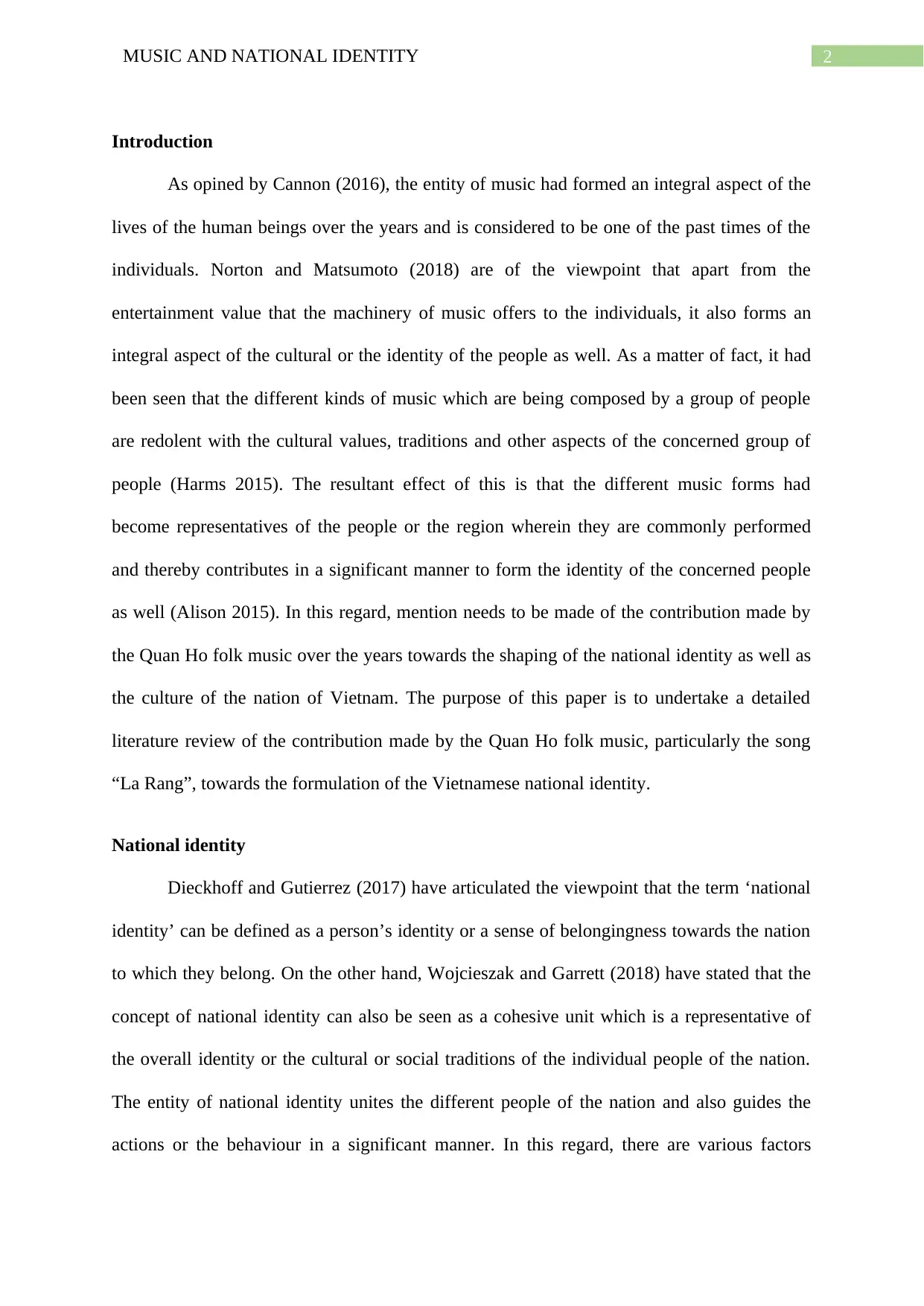
2MUSIC AND NATIONAL IDENTITY
Introduction
As opined by Cannon (2016), the entity of music had formed an integral aspect of the
lives of the human beings over the years and is considered to be one of the past times of the
individuals. Norton and Matsumoto (2018) are of the viewpoint that apart from the
entertainment value that the machinery of music offers to the individuals, it also forms an
integral aspect of the cultural or the identity of the people as well. As a matter of fact, it had
been seen that the different kinds of music which are being composed by a group of people
are redolent with the cultural values, traditions and other aspects of the concerned group of
people (Harms 2015). The resultant effect of this is that the different music forms had
become representatives of the people or the region wherein they are commonly performed
and thereby contributes in a significant manner to form the identity of the concerned people
as well (Alison 2015). In this regard, mention needs to be made of the contribution made by
the Quan Ho folk music over the years towards the shaping of the national identity as well as
the culture of the nation of Vietnam. The purpose of this paper is to undertake a detailed
literature review of the contribution made by the Quan Ho folk music, particularly the song
“La Rang”, towards the formulation of the Vietnamese national identity.
National identity
Dieckhoff and Gutierrez (2017) have articulated the viewpoint that the term ‘national
identity’ can be defined as a person’s identity or a sense of belongingness towards the nation
to which they belong. On the other hand, Wojcieszak and Garrett (2018) have stated that the
concept of national identity can also be seen as a cohesive unit which is a representative of
the overall identity or the cultural or social traditions of the individual people of the nation.
The entity of national identity unites the different people of the nation and also guides the
actions or the behaviour in a significant manner. In this regard, there are various factors
Introduction
As opined by Cannon (2016), the entity of music had formed an integral aspect of the
lives of the human beings over the years and is considered to be one of the past times of the
individuals. Norton and Matsumoto (2018) are of the viewpoint that apart from the
entertainment value that the machinery of music offers to the individuals, it also forms an
integral aspect of the cultural or the identity of the people as well. As a matter of fact, it had
been seen that the different kinds of music which are being composed by a group of people
are redolent with the cultural values, traditions and other aspects of the concerned group of
people (Harms 2015). The resultant effect of this is that the different music forms had
become representatives of the people or the region wherein they are commonly performed
and thereby contributes in a significant manner to form the identity of the concerned people
as well (Alison 2015). In this regard, mention needs to be made of the contribution made by
the Quan Ho folk music over the years towards the shaping of the national identity as well as
the culture of the nation of Vietnam. The purpose of this paper is to undertake a detailed
literature review of the contribution made by the Quan Ho folk music, particularly the song
“La Rang”, towards the formulation of the Vietnamese national identity.
National identity
Dieckhoff and Gutierrez (2017) have articulated the viewpoint that the term ‘national
identity’ can be defined as a person’s identity or a sense of belongingness towards the nation
to which they belong. On the other hand, Wojcieszak and Garrett (2018) have stated that the
concept of national identity can also be seen as a cohesive unit which is a representative of
the overall identity or the cultural or social traditions of the individual people of the nation.
The entity of national identity unites the different people of the nation and also guides the
actions or the behaviour in a significant manner. In this regard, there are various factors
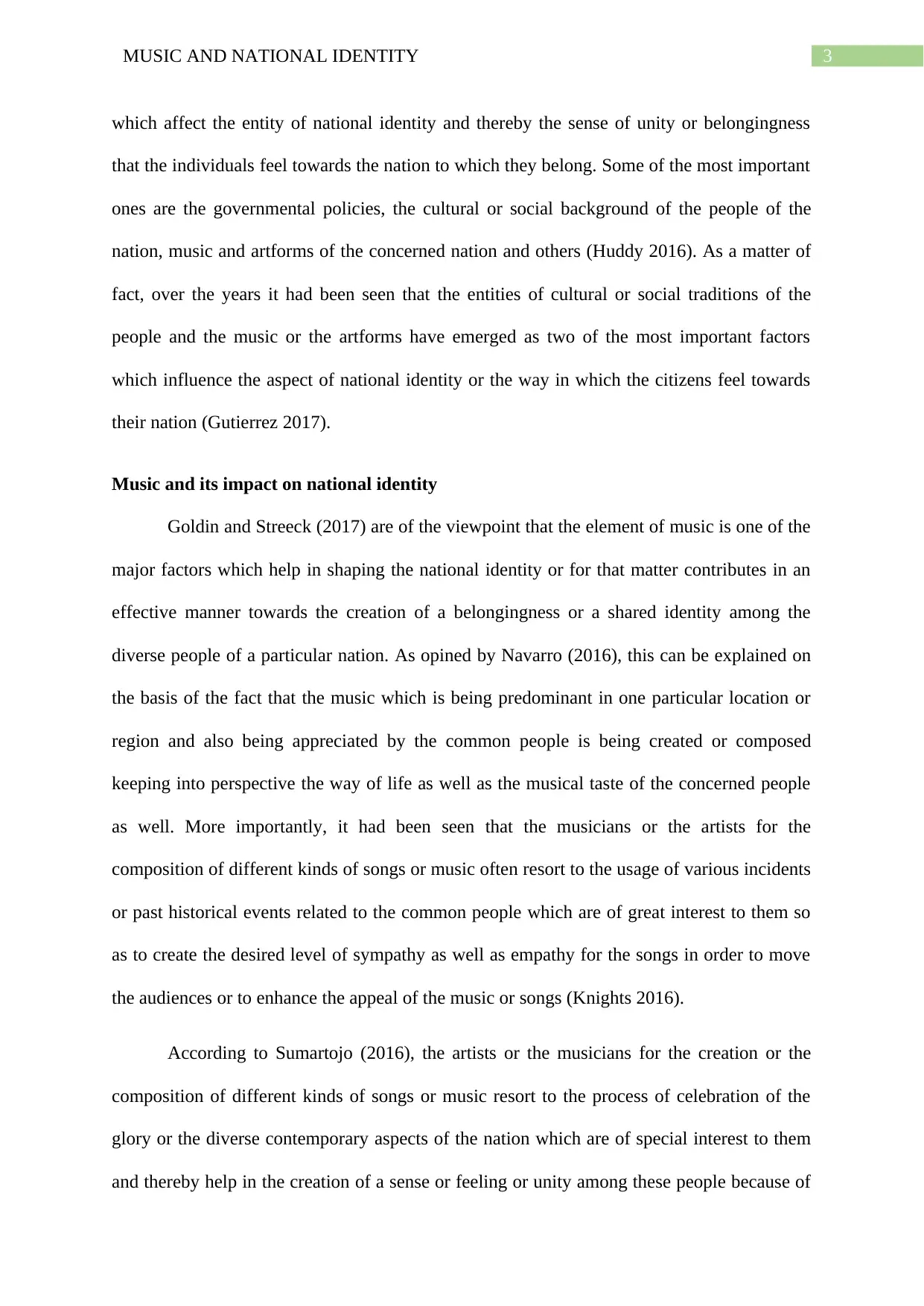
3MUSIC AND NATIONAL IDENTITY
which affect the entity of national identity and thereby the sense of unity or belongingness
that the individuals feel towards the nation to which they belong. Some of the most important
ones are the governmental policies, the cultural or social background of the people of the
nation, music and artforms of the concerned nation and others (Huddy 2016). As a matter of
fact, over the years it had been seen that the entities of cultural or social traditions of the
people and the music or the artforms have emerged as two of the most important factors
which influence the aspect of national identity or the way in which the citizens feel towards
their nation (Gutierrez 2017).
Music and its impact on national identity
Goldin and Streeck (2017) are of the viewpoint that the element of music is one of the
major factors which help in shaping the national identity or for that matter contributes in an
effective manner towards the creation of a belongingness or a shared identity among the
diverse people of a particular nation. As opined by Navarro (2016), this can be explained on
the basis of the fact that the music which is being predominant in one particular location or
region and also being appreciated by the common people is being created or composed
keeping into perspective the way of life as well as the musical taste of the concerned people
as well. More importantly, it had been seen that the musicians or the artists for the
composition of different kinds of songs or music often resort to the usage of various incidents
or past historical events related to the common people which are of great interest to them so
as to create the desired level of sympathy as well as empathy for the songs in order to move
the audiences or to enhance the appeal of the music or songs (Knights 2016).
According to Sumartojo (2016), the artists or the musicians for the creation or the
composition of different kinds of songs or music resort to the process of celebration of the
glory or the diverse contemporary aspects of the nation which are of special interest to them
and thereby help in the creation of a sense or feeling or unity among these people because of
which affect the entity of national identity and thereby the sense of unity or belongingness
that the individuals feel towards the nation to which they belong. Some of the most important
ones are the governmental policies, the cultural or social background of the people of the
nation, music and artforms of the concerned nation and others (Huddy 2016). As a matter of
fact, over the years it had been seen that the entities of cultural or social traditions of the
people and the music or the artforms have emerged as two of the most important factors
which influence the aspect of national identity or the way in which the citizens feel towards
their nation (Gutierrez 2017).
Music and its impact on national identity
Goldin and Streeck (2017) are of the viewpoint that the element of music is one of the
major factors which help in shaping the national identity or for that matter contributes in an
effective manner towards the creation of a belongingness or a shared identity among the
diverse people of a particular nation. As opined by Navarro (2016), this can be explained on
the basis of the fact that the music which is being predominant in one particular location or
region and also being appreciated by the common people is being created or composed
keeping into perspective the way of life as well as the musical taste of the concerned people
as well. More importantly, it had been seen that the musicians or the artists for the
composition of different kinds of songs or music often resort to the usage of various incidents
or past historical events related to the common people which are of great interest to them so
as to create the desired level of sympathy as well as empathy for the songs in order to move
the audiences or to enhance the appeal of the music or songs (Knights 2016).
According to Sumartojo (2016), the artists or the musicians for the creation or the
composition of different kinds of songs or music resort to the process of celebration of the
glory or the diverse contemporary aspects of the nation which are of special interest to them
and thereby help in the creation of a sense or feeling or unity among these people because of
Secure Best Marks with AI Grader
Need help grading? Try our AI Grader for instant feedback on your assignments.
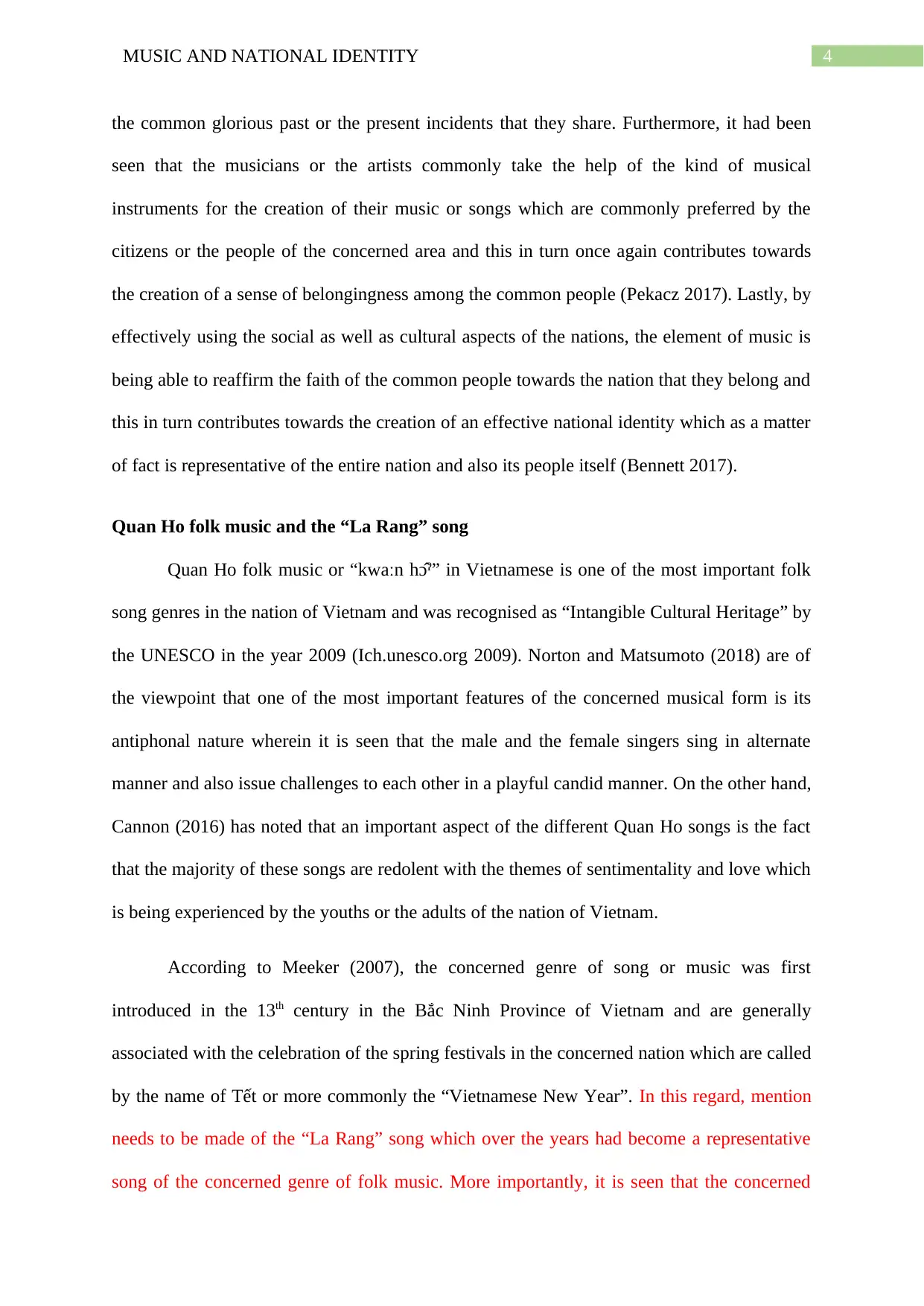
4MUSIC AND NATIONAL IDENTITY
the common glorious past or the present incidents that they share. Furthermore, it had been
seen that the musicians or the artists commonly take the help of the kind of musical
instruments for the creation of their music or songs which are commonly preferred by the
citizens or the people of the concerned area and this in turn once again contributes towards
the creation of a sense of belongingness among the common people (Pekacz 2017). Lastly, by
effectively using the social as well as cultural aspects of the nations, the element of music is
being able to reaffirm the faith of the common people towards the nation that they belong and
this in turn contributes towards the creation of an effective national identity which as a matter
of fact is representative of the entire nation and also its people itself (Bennett 2017).
Quan Ho folk music and the “La Rang” song
Quan Ho folk music or “kwaːn hɔ̂ˀ” in Vietnamese is one of the most important folk
song genres in the nation of Vietnam and was recognised as “Intangible Cultural Heritage” by
the UNESCO in the year 2009 (Ich.unesco.org 2009). Norton and Matsumoto (2018) are of
the viewpoint that one of the most important features of the concerned musical form is its
antiphonal nature wherein it is seen that the male and the female singers sing in alternate
manner and also issue challenges to each other in a playful candid manner. On the other hand,
Cannon (2016) has noted that an important aspect of the different Quan Ho songs is the fact
that the majority of these songs are redolent with the themes of sentimentality and love which
is being experienced by the youths or the adults of the nation of Vietnam.
According to Meeker (2007), the concerned genre of song or music was first
introduced in the 13th century in the Bắc Ninh Province of Vietnam and are generally
associated with the celebration of the spring festivals in the concerned nation which are called
by the name of Tết or more commonly the “Vietnamese New Year”. In this regard, mention
needs to be made of the “La Rang” song which over the years had become a representative
song of the concerned genre of folk music. More importantly, it is seen that the concerned
the common glorious past or the present incidents that they share. Furthermore, it had been
seen that the musicians or the artists commonly take the help of the kind of musical
instruments for the creation of their music or songs which are commonly preferred by the
citizens or the people of the concerned area and this in turn once again contributes towards
the creation of a sense of belongingness among the common people (Pekacz 2017). Lastly, by
effectively using the social as well as cultural aspects of the nations, the element of music is
being able to reaffirm the faith of the common people towards the nation that they belong and
this in turn contributes towards the creation of an effective national identity which as a matter
of fact is representative of the entire nation and also its people itself (Bennett 2017).
Quan Ho folk music and the “La Rang” song
Quan Ho folk music or “kwaːn hɔ̂ˀ” in Vietnamese is one of the most important folk
song genres in the nation of Vietnam and was recognised as “Intangible Cultural Heritage” by
the UNESCO in the year 2009 (Ich.unesco.org 2009). Norton and Matsumoto (2018) are of
the viewpoint that one of the most important features of the concerned musical form is its
antiphonal nature wherein it is seen that the male and the female singers sing in alternate
manner and also issue challenges to each other in a playful candid manner. On the other hand,
Cannon (2016) has noted that an important aspect of the different Quan Ho songs is the fact
that the majority of these songs are redolent with the themes of sentimentality and love which
is being experienced by the youths or the adults of the nation of Vietnam.
According to Meeker (2007), the concerned genre of song or music was first
introduced in the 13th century in the Bắc Ninh Province of Vietnam and are generally
associated with the celebration of the spring festivals in the concerned nation which are called
by the name of Tết or more commonly the “Vietnamese New Year”. In this regard, mention
needs to be made of the “La Rang” song which over the years had become a representative
song of the concerned genre of folk music. More importantly, it is seen that the concerned
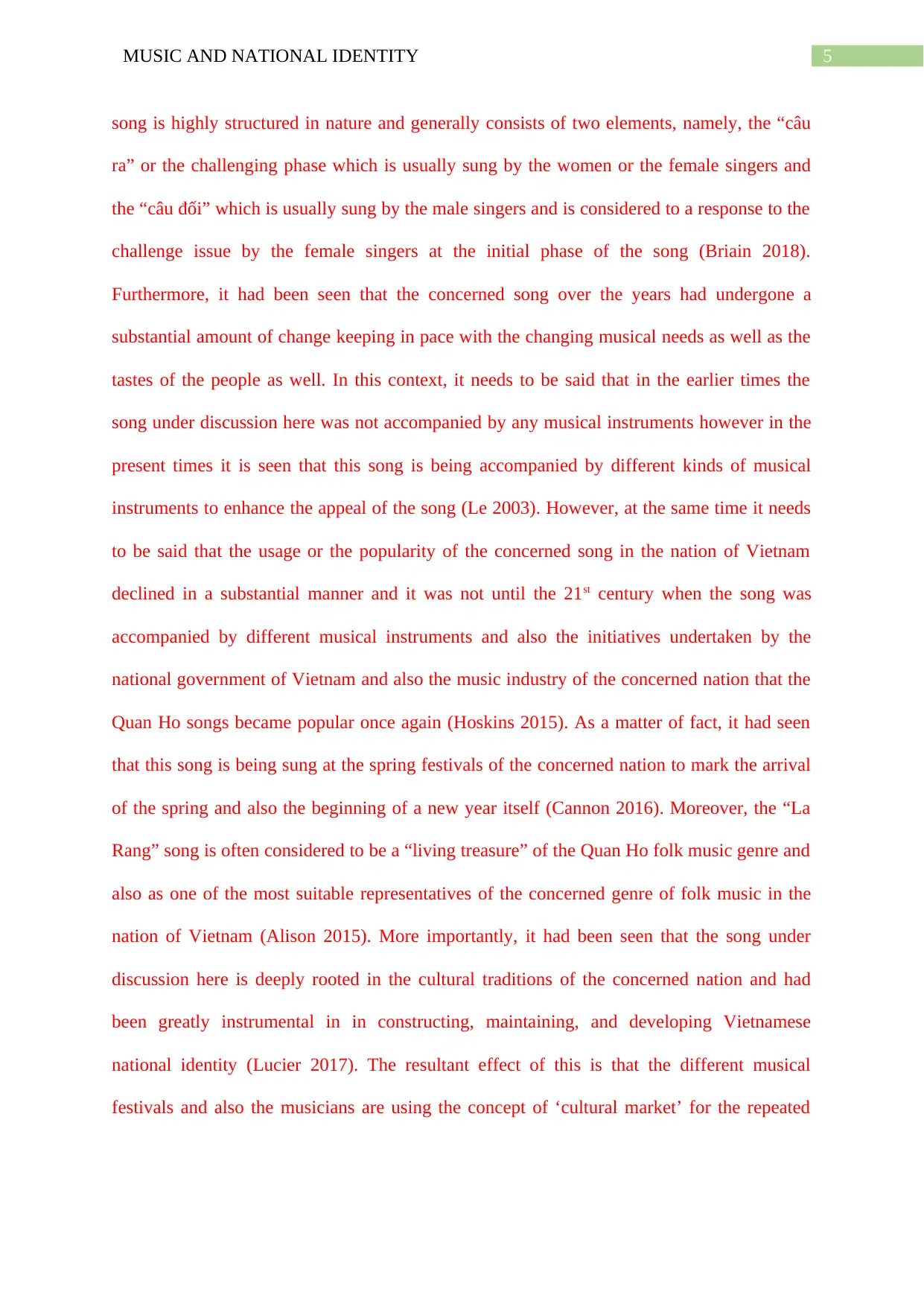
5MUSIC AND NATIONAL IDENTITY
song is highly structured in nature and generally consists of two elements, namely, the “câu
ra” or the challenging phase which is usually sung by the women or the female singers and
the “câu đối” which is usually sung by the male singers and is considered to a response to the
challenge issue by the female singers at the initial phase of the song (Briain 2018).
Furthermore, it had been seen that the concerned song over the years had undergone a
substantial amount of change keeping in pace with the changing musical needs as well as the
tastes of the people as well. In this context, it needs to be said that in the earlier times the
song under discussion here was not accompanied by any musical instruments however in the
present times it is seen that this song is being accompanied by different kinds of musical
instruments to enhance the appeal of the song (Le 2003). However, at the same time it needs
to be said that the usage or the popularity of the concerned song in the nation of Vietnam
declined in a substantial manner and it was not until the 21st century when the song was
accompanied by different musical instruments and also the initiatives undertaken by the
national government of Vietnam and also the music industry of the concerned nation that the
Quan Ho songs became popular once again (Hoskins 2015). As a matter of fact, it had seen
that this song is being sung at the spring festivals of the concerned nation to mark the arrival
of the spring and also the beginning of a new year itself (Cannon 2016). Moreover, the “La
Rang” song is often considered to be a “living treasure” of the Quan Ho folk music genre and
also as one of the most suitable representatives of the concerned genre of folk music in the
nation of Vietnam (Alison 2015). More importantly, it had been seen that the song under
discussion here is deeply rooted in the cultural traditions of the concerned nation and had
been greatly instrumental in in constructing, maintaining, and developing Vietnamese
national identity (Lucier 2017). The resultant effect of this is that the different musical
festivals and also the musicians are using the concept of ‘cultural market’ for the repeated
song is highly structured in nature and generally consists of two elements, namely, the “câu
ra” or the challenging phase which is usually sung by the women or the female singers and
the “câu đối” which is usually sung by the male singers and is considered to a response to the
challenge issue by the female singers at the initial phase of the song (Briain 2018).
Furthermore, it had been seen that the concerned song over the years had undergone a
substantial amount of change keeping in pace with the changing musical needs as well as the
tastes of the people as well. In this context, it needs to be said that in the earlier times the
song under discussion here was not accompanied by any musical instruments however in the
present times it is seen that this song is being accompanied by different kinds of musical
instruments to enhance the appeal of the song (Le 2003). However, at the same time it needs
to be said that the usage or the popularity of the concerned song in the nation of Vietnam
declined in a substantial manner and it was not until the 21st century when the song was
accompanied by different musical instruments and also the initiatives undertaken by the
national government of Vietnam and also the music industry of the concerned nation that the
Quan Ho songs became popular once again (Hoskins 2015). As a matter of fact, it had seen
that this song is being sung at the spring festivals of the concerned nation to mark the arrival
of the spring and also the beginning of a new year itself (Cannon 2016). Moreover, the “La
Rang” song is often considered to be a “living treasure” of the Quan Ho folk music genre and
also as one of the most suitable representatives of the concerned genre of folk music in the
nation of Vietnam (Alison 2015). More importantly, it had been seen that the song under
discussion here is deeply rooted in the cultural traditions of the concerned nation and had
been greatly instrumental in in constructing, maintaining, and developing Vietnamese
national identity (Lucier 2017). The resultant effect of this is that the different musical
festivals and also the musicians are using the concept of ‘cultural market’ for the repeated
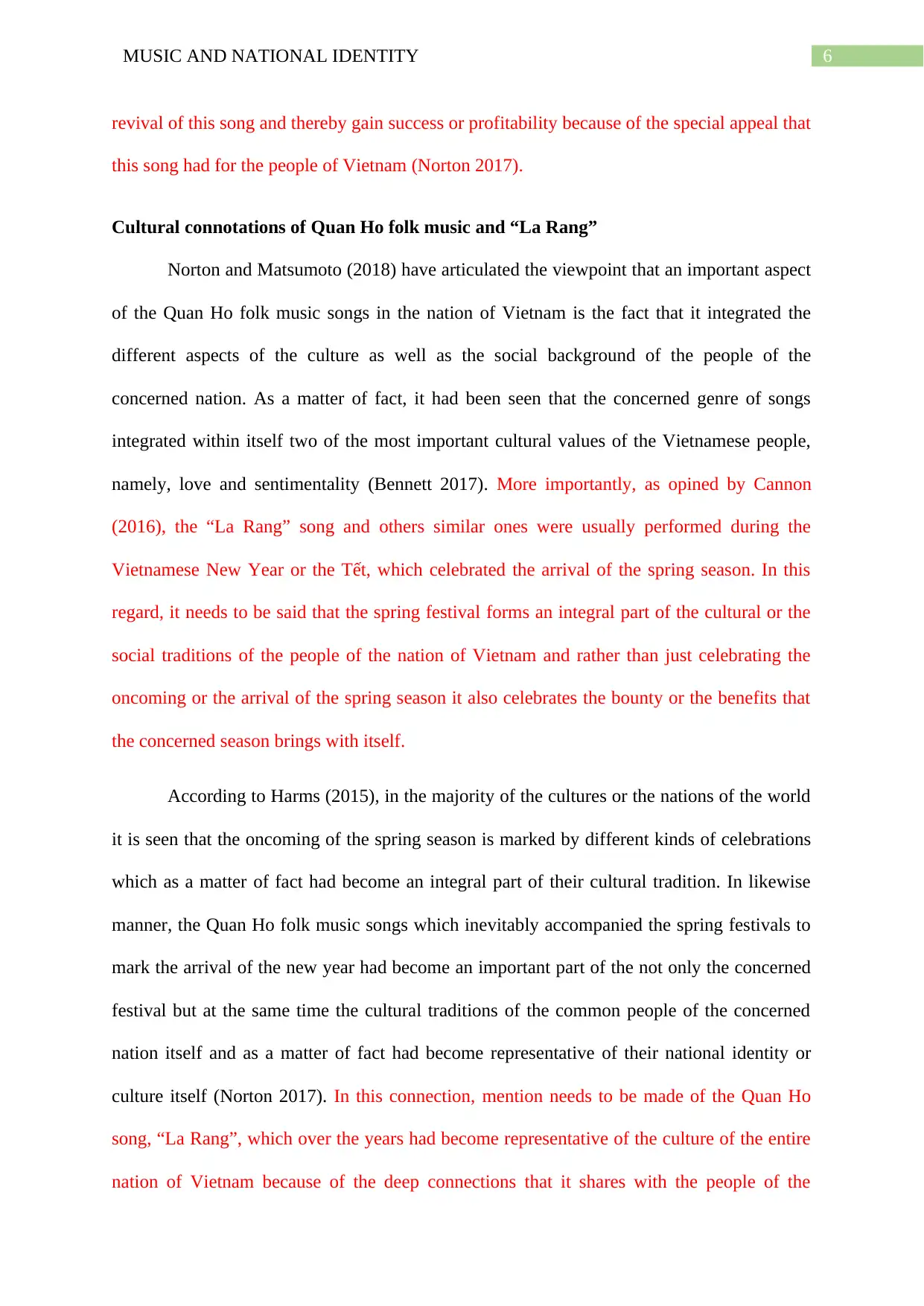
6MUSIC AND NATIONAL IDENTITY
revival of this song and thereby gain success or profitability because of the special appeal that
this song had for the people of Vietnam (Norton 2017).
Cultural connotations of Quan Ho folk music and “La Rang”
Norton and Matsumoto (2018) have articulated the viewpoint that an important aspect
of the Quan Ho folk music songs in the nation of Vietnam is the fact that it integrated the
different aspects of the culture as well as the social background of the people of the
concerned nation. As a matter of fact, it had been seen that the concerned genre of songs
integrated within itself two of the most important cultural values of the Vietnamese people,
namely, love and sentimentality (Bennett 2017). More importantly, as opined by Cannon
(2016), the “La Rang” song and others similar ones were usually performed during the
Vietnamese New Year or the Tết, which celebrated the arrival of the spring season. In this
regard, it needs to be said that the spring festival forms an integral part of the cultural or the
social traditions of the people of the nation of Vietnam and rather than just celebrating the
oncoming or the arrival of the spring season it also celebrates the bounty or the benefits that
the concerned season brings with itself.
According to Harms (2015), in the majority of the cultures or the nations of the world
it is seen that the oncoming of the spring season is marked by different kinds of celebrations
which as a matter of fact had become an integral part of their cultural tradition. In likewise
manner, the Quan Ho folk music songs which inevitably accompanied the spring festivals to
mark the arrival of the new year had become an important part of the not only the concerned
festival but at the same time the cultural traditions of the common people of the concerned
nation itself and as a matter of fact had become representative of their national identity or
culture itself (Norton 2017). In this connection, mention needs to be made of the Quan Ho
song, “La Rang”, which over the years had become representative of the culture of the entire
nation of Vietnam because of the deep connections that it shares with the people of the
revival of this song and thereby gain success or profitability because of the special appeal that
this song had for the people of Vietnam (Norton 2017).
Cultural connotations of Quan Ho folk music and “La Rang”
Norton and Matsumoto (2018) have articulated the viewpoint that an important aspect
of the Quan Ho folk music songs in the nation of Vietnam is the fact that it integrated the
different aspects of the culture as well as the social background of the people of the
concerned nation. As a matter of fact, it had been seen that the concerned genre of songs
integrated within itself two of the most important cultural values of the Vietnamese people,
namely, love and sentimentality (Bennett 2017). More importantly, as opined by Cannon
(2016), the “La Rang” song and others similar ones were usually performed during the
Vietnamese New Year or the Tết, which celebrated the arrival of the spring season. In this
regard, it needs to be said that the spring festival forms an integral part of the cultural or the
social traditions of the people of the nation of Vietnam and rather than just celebrating the
oncoming or the arrival of the spring season it also celebrates the bounty or the benefits that
the concerned season brings with itself.
According to Harms (2015), in the majority of the cultures or the nations of the world
it is seen that the oncoming of the spring season is marked by different kinds of celebrations
which as a matter of fact had become an integral part of their cultural tradition. In likewise
manner, the Quan Ho folk music songs which inevitably accompanied the spring festivals to
mark the arrival of the new year had become an important part of the not only the concerned
festival but at the same time the cultural traditions of the common people of the concerned
nation itself and as a matter of fact had become representative of their national identity or
culture itself (Norton 2017). In this connection, mention needs to be made of the Quan Ho
song, “La Rang”, which over the years had become representative of the culture of the entire
nation of Vietnam because of the deep connections that it shares with the people of the
Paraphrase This Document
Need a fresh take? Get an instant paraphrase of this document with our AI Paraphraser
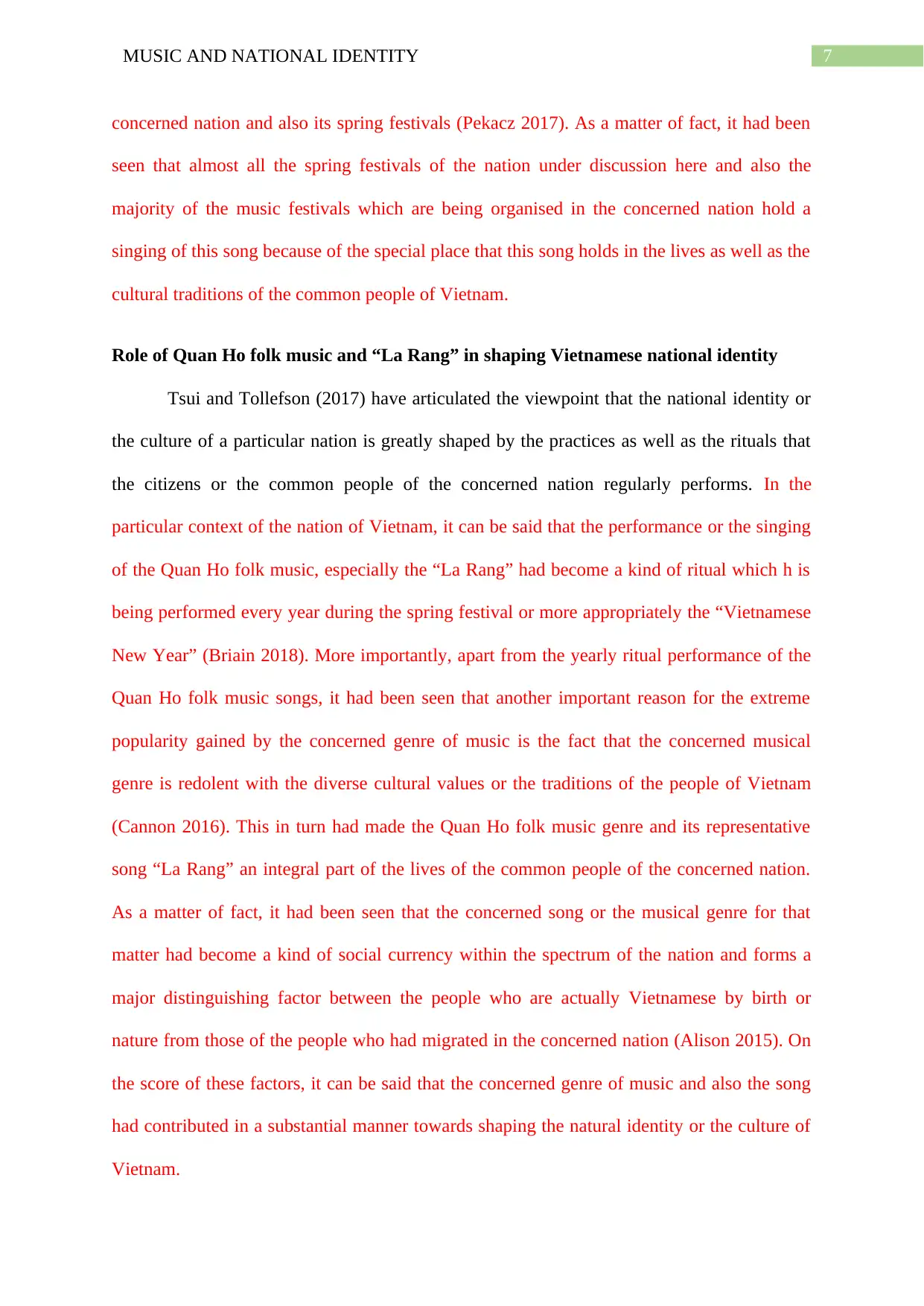
7MUSIC AND NATIONAL IDENTITY
concerned nation and also its spring festivals (Pekacz 2017). As a matter of fact, it had been
seen that almost all the spring festivals of the nation under discussion here and also the
majority of the music festivals which are being organised in the concerned nation hold a
singing of this song because of the special place that this song holds in the lives as well as the
cultural traditions of the common people of Vietnam.
Role of Quan Ho folk music and “La Rang” in shaping Vietnamese national identity
Tsui and Tollefson (2017) have articulated the viewpoint that the national identity or
the culture of a particular nation is greatly shaped by the practices as well as the rituals that
the citizens or the common people of the concerned nation regularly performs. In the
particular context of the nation of Vietnam, it can be said that the performance or the singing
of the Quan Ho folk music, especially the “La Rang” had become a kind of ritual which h is
being performed every year during the spring festival or more appropriately the “Vietnamese
New Year” (Briain 2018). More importantly, apart from the yearly ritual performance of the
Quan Ho folk music songs, it had been seen that another important reason for the extreme
popularity gained by the concerned genre of music is the fact that the concerned musical
genre is redolent with the diverse cultural values or the traditions of the people of Vietnam
(Cannon 2016). This in turn had made the Quan Ho folk music genre and its representative
song “La Rang” an integral part of the lives of the common people of the concerned nation.
As a matter of fact, it had been seen that the concerned song or the musical genre for that
matter had become a kind of social currency within the spectrum of the nation and forms a
major distinguishing factor between the people who are actually Vietnamese by birth or
nature from those of the people who had migrated in the concerned nation (Alison 2015). On
the score of these factors, it can be said that the concerned genre of music and also the song
had contributed in a substantial manner towards shaping the natural identity or the culture of
Vietnam.
concerned nation and also its spring festivals (Pekacz 2017). As a matter of fact, it had been
seen that almost all the spring festivals of the nation under discussion here and also the
majority of the music festivals which are being organised in the concerned nation hold a
singing of this song because of the special place that this song holds in the lives as well as the
cultural traditions of the common people of Vietnam.
Role of Quan Ho folk music and “La Rang” in shaping Vietnamese national identity
Tsui and Tollefson (2017) have articulated the viewpoint that the national identity or
the culture of a particular nation is greatly shaped by the practices as well as the rituals that
the citizens or the common people of the concerned nation regularly performs. In the
particular context of the nation of Vietnam, it can be said that the performance or the singing
of the Quan Ho folk music, especially the “La Rang” had become a kind of ritual which h is
being performed every year during the spring festival or more appropriately the “Vietnamese
New Year” (Briain 2018). More importantly, apart from the yearly ritual performance of the
Quan Ho folk music songs, it had been seen that another important reason for the extreme
popularity gained by the concerned genre of music is the fact that the concerned musical
genre is redolent with the diverse cultural values or the traditions of the people of Vietnam
(Cannon 2016). This in turn had made the Quan Ho folk music genre and its representative
song “La Rang” an integral part of the lives of the common people of the concerned nation.
As a matter of fact, it had been seen that the concerned song or the musical genre for that
matter had become a kind of social currency within the spectrum of the nation and forms a
major distinguishing factor between the people who are actually Vietnamese by birth or
nature from those of the people who had migrated in the concerned nation (Alison 2015). On
the score of these factors, it can be said that the concerned genre of music and also the song
had contributed in a substantial manner towards shaping the natural identity or the culture of
Vietnam.
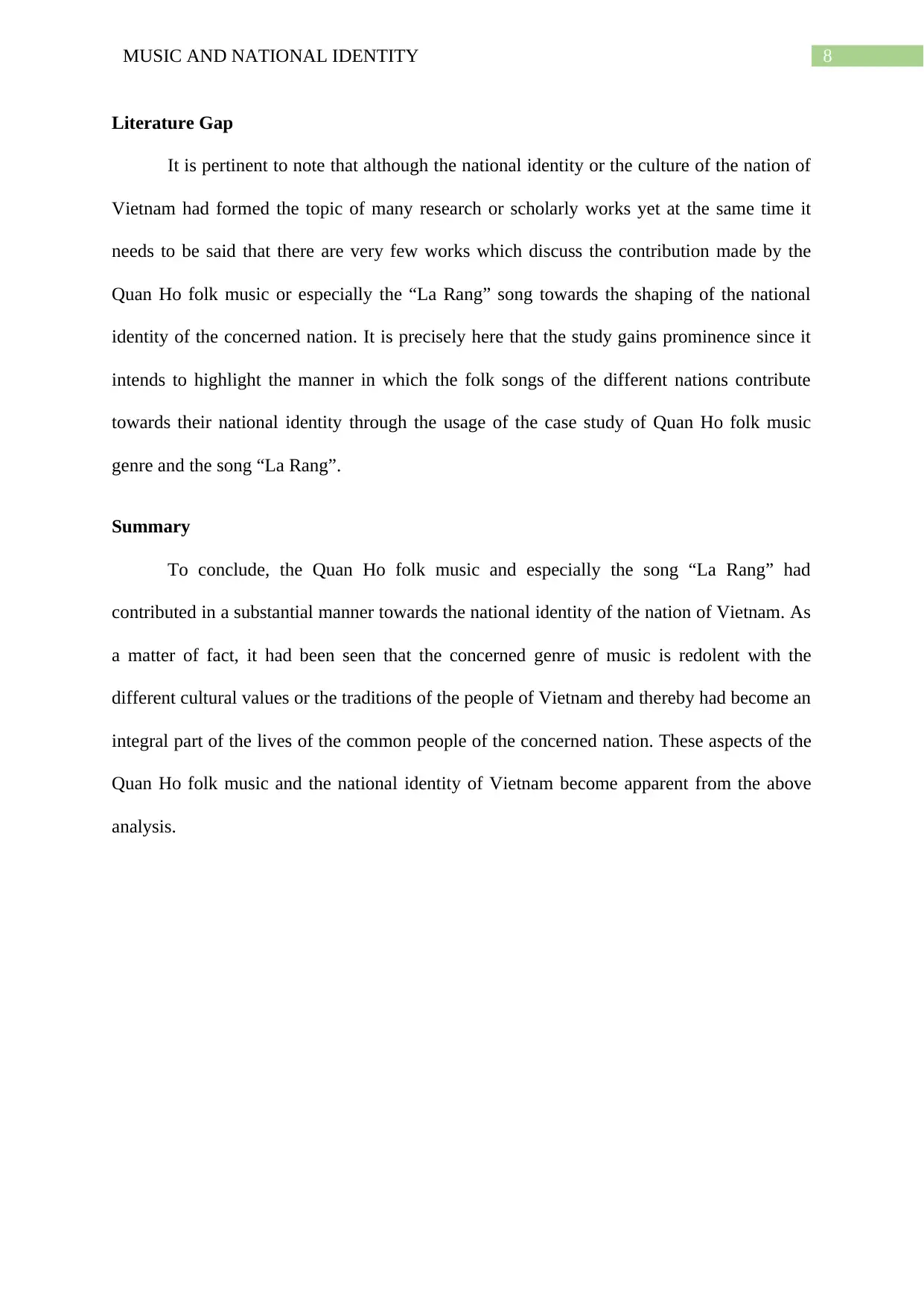
8MUSIC AND NATIONAL IDENTITY
Literature Gap
It is pertinent to note that although the national identity or the culture of the nation of
Vietnam had formed the topic of many research or scholarly works yet at the same time it
needs to be said that there are very few works which discuss the contribution made by the
Quan Ho folk music or especially the “La Rang” song towards the shaping of the national
identity of the concerned nation. It is precisely here that the study gains prominence since it
intends to highlight the manner in which the folk songs of the different nations contribute
towards their national identity through the usage of the case study of Quan Ho folk music
genre and the song “La Rang”.
Summary
To conclude, the Quan Ho folk music and especially the song “La Rang” had
contributed in a substantial manner towards the national identity of the nation of Vietnam. As
a matter of fact, it had been seen that the concerned genre of music is redolent with the
different cultural values or the traditions of the people of Vietnam and thereby had become an
integral part of the lives of the common people of the concerned nation. These aspects of the
Quan Ho folk music and the national identity of Vietnam become apparent from the above
analysis.
Literature Gap
It is pertinent to note that although the national identity or the culture of the nation of
Vietnam had formed the topic of many research or scholarly works yet at the same time it
needs to be said that there are very few works which discuss the contribution made by the
Quan Ho folk music or especially the “La Rang” song towards the shaping of the national
identity of the concerned nation. It is precisely here that the study gains prominence since it
intends to highlight the manner in which the folk songs of the different nations contribute
towards their national identity through the usage of the case study of Quan Ho folk music
genre and the song “La Rang”.
Summary
To conclude, the Quan Ho folk music and especially the song “La Rang” had
contributed in a substantial manner towards the national identity of the nation of Vietnam. As
a matter of fact, it had been seen that the concerned genre of music is redolent with the
different cultural values or the traditions of the people of Vietnam and thereby had become an
integral part of the lives of the common people of the concerned nation. These aspects of the
Quan Ho folk music and the national identity of Vietnam become apparent from the above
analysis.
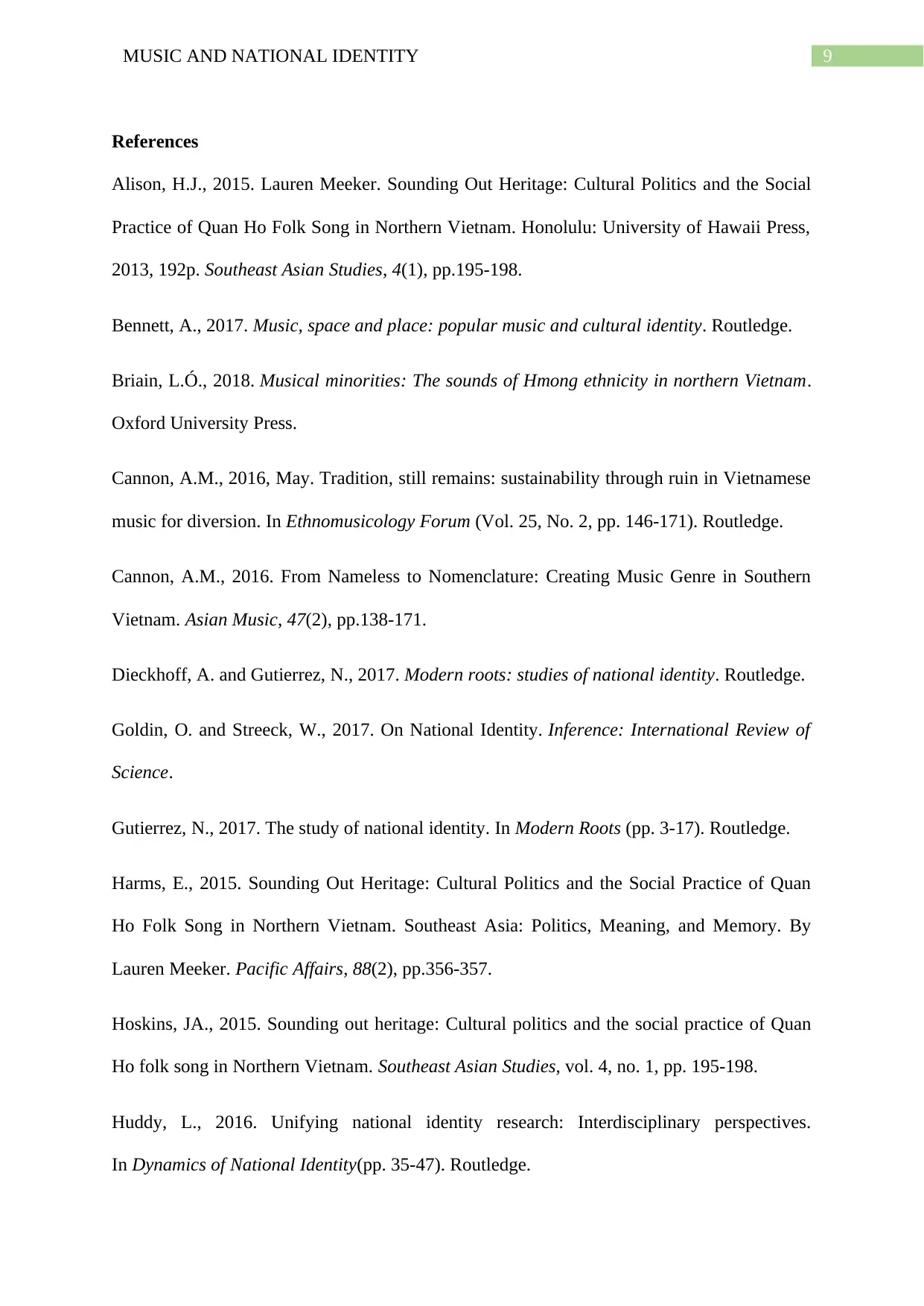
9MUSIC AND NATIONAL IDENTITY
References
Alison, H.J., 2015. Lauren Meeker. Sounding Out Heritage: Cultural Politics and the Social
Practice of Quan Ho Folk Song in Northern Vietnam. Honolulu: University of Hawaii Press,
2013, 192p. Southeast Asian Studies, 4(1), pp.195-198.
Bennett, A., 2017. Music, space and place: popular music and cultural identity. Routledge.
Briain, L.Ó., 2018. Musical minorities: The sounds of Hmong ethnicity in northern Vietnam.
Oxford University Press.
Cannon, A.M., 2016, May. Tradition, still remains: sustainability through ruin in Vietnamese
music for diversion. In Ethnomusicology Forum (Vol. 25, No. 2, pp. 146-171). Routledge.
Cannon, A.M., 2016. From Nameless to Nomenclature: Creating Music Genre in Southern
Vietnam. Asian Music, 47(2), pp.138-171.
Dieckhoff, A. and Gutierrez, N., 2017. Modern roots: studies of national identity. Routledge.
Goldin, O. and Streeck, W., 2017. On National Identity. Inference: International Review of
Science.
Gutierrez, N., 2017. The study of national identity. In Modern Roots (pp. 3-17). Routledge.
Harms, E., 2015. Sounding Out Heritage: Cultural Politics and the Social Practice of Quan
Ho Folk Song in Northern Vietnam. Southeast Asia: Politics, Meaning, and Memory. By
Lauren Meeker. Pacific Affairs, 88(2), pp.356-357.
Hoskins, JA., 2015. Sounding out heritage: Cultural politics and the social practice of Quan
Ho folk song in Northern Vietnam. Southeast Asian Studies, vol. 4, no. 1, pp. 195-198.
Huddy, L., 2016. Unifying national identity research: Interdisciplinary perspectives.
In Dynamics of National Identity(pp. 35-47). Routledge.
References
Alison, H.J., 2015. Lauren Meeker. Sounding Out Heritage: Cultural Politics and the Social
Practice of Quan Ho Folk Song in Northern Vietnam. Honolulu: University of Hawaii Press,
2013, 192p. Southeast Asian Studies, 4(1), pp.195-198.
Bennett, A., 2017. Music, space and place: popular music and cultural identity. Routledge.
Briain, L.Ó., 2018. Musical minorities: The sounds of Hmong ethnicity in northern Vietnam.
Oxford University Press.
Cannon, A.M., 2016, May. Tradition, still remains: sustainability through ruin in Vietnamese
music for diversion. In Ethnomusicology Forum (Vol. 25, No. 2, pp. 146-171). Routledge.
Cannon, A.M., 2016. From Nameless to Nomenclature: Creating Music Genre in Southern
Vietnam. Asian Music, 47(2), pp.138-171.
Dieckhoff, A. and Gutierrez, N., 2017. Modern roots: studies of national identity. Routledge.
Goldin, O. and Streeck, W., 2017. On National Identity. Inference: International Review of
Science.
Gutierrez, N., 2017. The study of national identity. In Modern Roots (pp. 3-17). Routledge.
Harms, E., 2015. Sounding Out Heritage: Cultural Politics and the Social Practice of Quan
Ho Folk Song in Northern Vietnam. Southeast Asia: Politics, Meaning, and Memory. By
Lauren Meeker. Pacific Affairs, 88(2), pp.356-357.
Hoskins, JA., 2015. Sounding out heritage: Cultural politics and the social practice of Quan
Ho folk song in Northern Vietnam. Southeast Asian Studies, vol. 4, no. 1, pp. 195-198.
Huddy, L., 2016. Unifying national identity research: Interdisciplinary perspectives.
In Dynamics of National Identity(pp. 35-47). Routledge.
Secure Best Marks with AI Grader
Need help grading? Try our AI Grader for instant feedback on your assignments.
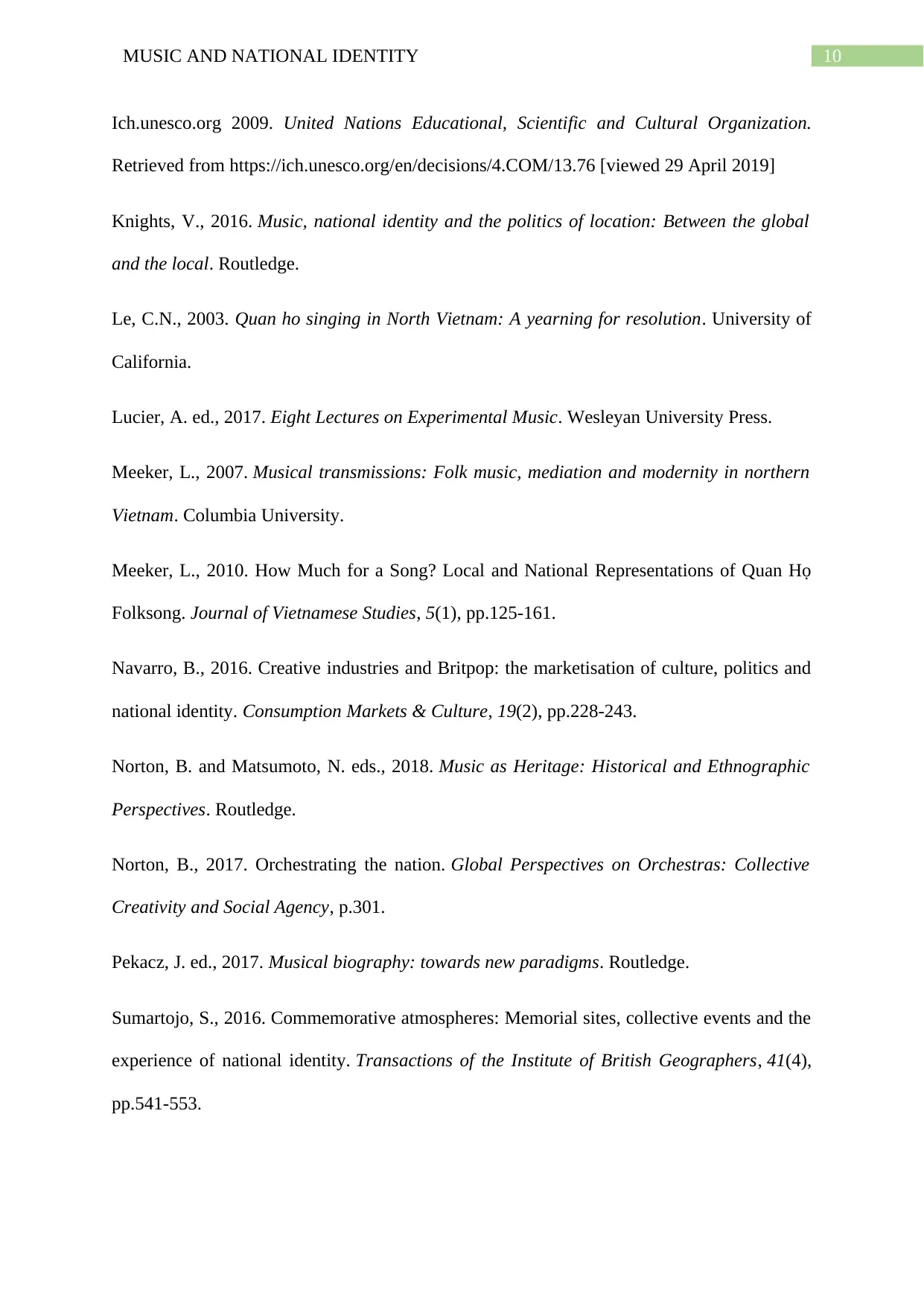
10MUSIC AND NATIONAL IDENTITY
Ich.unesco.org 2009. United Nations Educational, Scientific and Cultural Organization.
Retrieved from https://ich.unesco.org/en/decisions/4.COM/13.76 [viewed 29 April 2019]
Knights, V., 2016. Music, national identity and the politics of location: Between the global
and the local. Routledge.
Le, C.N., 2003. Quan ho singing in North Vietnam: A yearning for resolution. University of
California.
Lucier, A. ed., 2017. Eight Lectures on Experimental Music. Wesleyan University Press.
Meeker, L., 2007. Musical transmissions: Folk music, mediation and modernity in northern
Vietnam. Columbia University.
Meeker, L., 2010. How Much for a Song? Local and National Representations of Quan Họ
Folksong. Journal of Vietnamese Studies, 5(1), pp.125-161.
Navarro, B., 2016. Creative industries and Britpop: the marketisation of culture, politics and
national identity. Consumption Markets & Culture, 19(2), pp.228-243.
Norton, B. and Matsumoto, N. eds., 2018. Music as Heritage: Historical and Ethnographic
Perspectives. Routledge.
Norton, B., 2017. Orchestrating the nation. Global Perspectives on Orchestras: Collective
Creativity and Social Agency, p.301.
Pekacz, J. ed., 2017. Musical biography: towards new paradigms. Routledge.
Sumartojo, S., 2016. Commemorative atmospheres: Memorial sites, collective events and the
experience of national identity. Transactions of the Institute of British Geographers, 41(4),
pp.541-553.
Ich.unesco.org 2009. United Nations Educational, Scientific and Cultural Organization.
Retrieved from https://ich.unesco.org/en/decisions/4.COM/13.76 [viewed 29 April 2019]
Knights, V., 2016. Music, national identity and the politics of location: Between the global
and the local. Routledge.
Le, C.N., 2003. Quan ho singing in North Vietnam: A yearning for resolution. University of
California.
Lucier, A. ed., 2017. Eight Lectures on Experimental Music. Wesleyan University Press.
Meeker, L., 2007. Musical transmissions: Folk music, mediation and modernity in northern
Vietnam. Columbia University.
Meeker, L., 2010. How Much for a Song? Local and National Representations of Quan Họ
Folksong. Journal of Vietnamese Studies, 5(1), pp.125-161.
Navarro, B., 2016. Creative industries and Britpop: the marketisation of culture, politics and
national identity. Consumption Markets & Culture, 19(2), pp.228-243.
Norton, B. and Matsumoto, N. eds., 2018. Music as Heritage: Historical and Ethnographic
Perspectives. Routledge.
Norton, B., 2017. Orchestrating the nation. Global Perspectives on Orchestras: Collective
Creativity and Social Agency, p.301.
Pekacz, J. ed., 2017. Musical biography: towards new paradigms. Routledge.
Sumartojo, S., 2016. Commemorative atmospheres: Memorial sites, collective events and the
experience of national identity. Transactions of the Institute of British Geographers, 41(4),
pp.541-553.
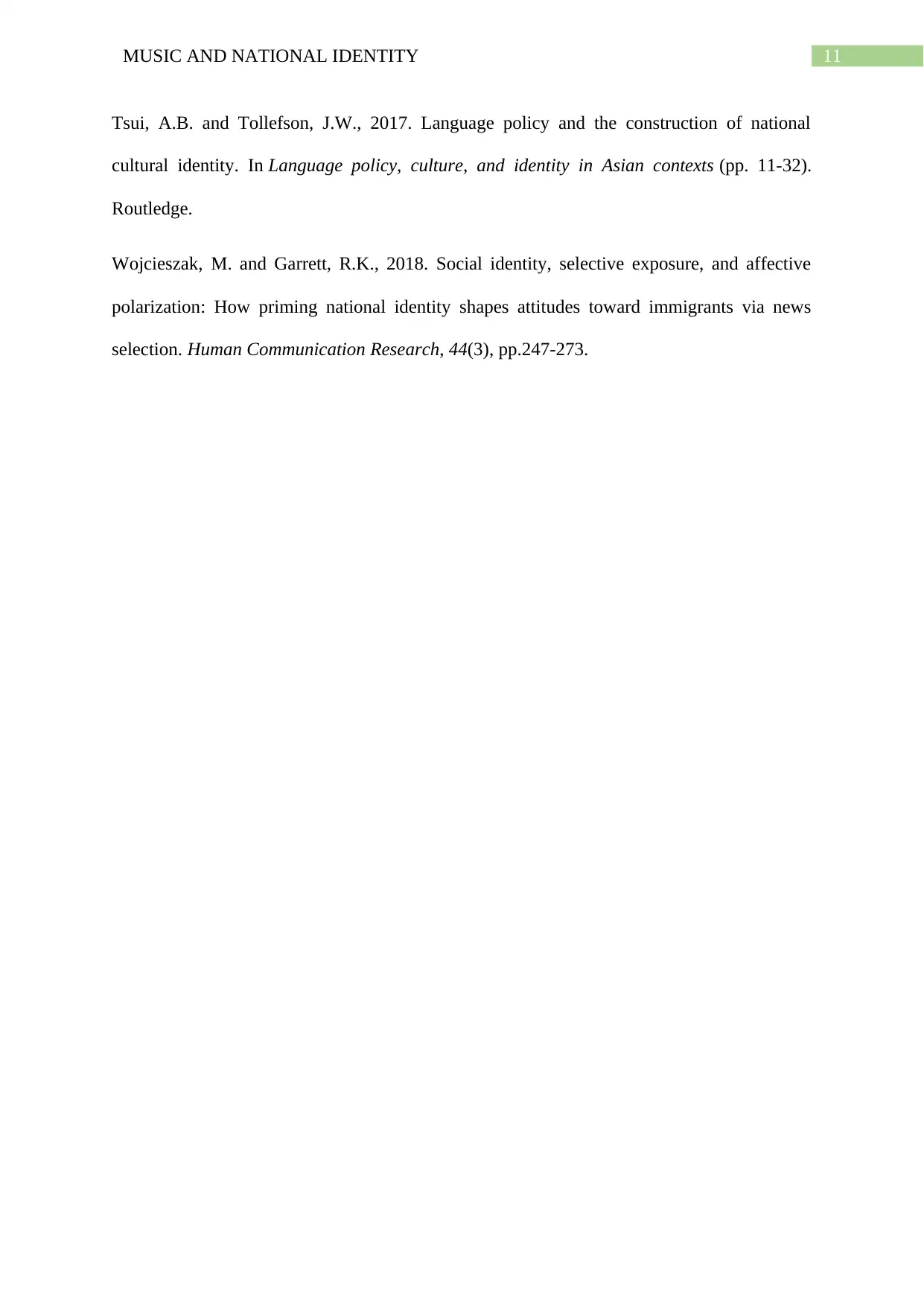
11MUSIC AND NATIONAL IDENTITY
Tsui, A.B. and Tollefson, J.W., 2017. Language policy and the construction of national
cultural identity. In Language policy, culture, and identity in Asian contexts (pp. 11-32).
Routledge.
Wojcieszak, M. and Garrett, R.K., 2018. Social identity, selective exposure, and affective
polarization: How priming national identity shapes attitudes toward immigrants via news
selection. Human Communication Research, 44(3), pp.247-273.
Tsui, A.B. and Tollefson, J.W., 2017. Language policy and the construction of national
cultural identity. In Language policy, culture, and identity in Asian contexts (pp. 11-32).
Routledge.
Wojcieszak, M. and Garrett, R.K., 2018. Social identity, selective exposure, and affective
polarization: How priming national identity shapes attitudes toward immigrants via news
selection. Human Communication Research, 44(3), pp.247-273.
1 out of 12
Your All-in-One AI-Powered Toolkit for Academic Success.
+13062052269
info@desklib.com
Available 24*7 on WhatsApp / Email
![[object Object]](/_next/static/media/star-bottom.7253800d.svg)
Unlock your academic potential
© 2024 | Zucol Services PVT LTD | All rights reserved.
